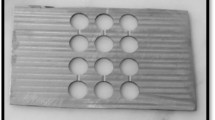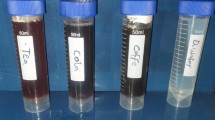Abstract
The purpose of this investigation was to evaluate the mechanical properties of provisional restorative materials after storage in dietary simulating solvents. A total of 120 specimens, 40 specimens each of Luxatemp Star, Revotek LC and DPI Self Cure were prepared. The specimens were divided into four groups with 10 specimens each and stored in dietary simulating solvents for 7 days at 37 °C as follows: Group I—Control, Group II—Artificial saliva, Group III—0.02 N Citric acid and Group IV—Heptane. After 7 days, flexural strength was obtained using universal testing machine at a crosshead speed of 5 mm/min and the fractured specimens were immediately subjected to the microhardness test knoop hardness number by using Knoop microhardness tester (10 gm/15 s). The data were analyzed for difference by use of Kruskal–Wallis and Dunn’s multiple comparison tests using a significance level of 0.05 to determine the mean differences. Significant effect was observed on the properties of provisional restorative materials after storage in dietary simulating solvents as compared to the control group (p ≤ 0.05). Bis-acryl resin based Luxatemp Star showed significantly superior flexural strength and hardness as compared to the Revotek LC and DPI Self Cure in dietary simulating solvents. Within the limitations of this study, it may be concluded that dietary simulating solvents showed significant influence on the mechanical properties of the provisional restorative materials.








Similar content being viewed by others
References
Higginbottom FL (1995) Quality provisional restorations: a must for successful restorative dentistry. Compend Contin Educ Dent 16(442):444–447
Akova T, Ozkomur A, Uysal H (2006) Effect of food-simulating liquids on the mechanical properties of provisional restorative materials. Dent Mater 22:1130–1134
Gough M (1994) A review of temporary crowns and bridges. Dent Update 21:203–207
Yap AUJ, Mah MKS, Lye CPW, Loh PL (2004) Influence of dietary simulating solvents on the hardness of provisional restorative materials. Dent Mater 20:370–376
Vahidi F (1987) The provisional restoration. Dent Clin North Am 31:363–381
Burns DR, Beck DA, Nelson SK (2003) A review of selected dental literature on contemporary provisional fixed prosthodontic treatment: report of the Committee on Research in Fixed Prosthodontics of the Academy of Fixed Prosthodontics. J Prosthet Dent 90:474–497
Gegauff AG, Holloway JA (2001) Provisional restorations. In: Rosenstiel SF, Land MF, Fujimoto J (eds) Contemporary fixed prosthodontics, 3rd edn. Mosby Inc., St. Louis, pp 380–416
Balkenhol M, Mautner MC, Ferger P, Wostmann B (2008) Mechanical properties of provisional crown and bridge materials: chemical-curing versus dual-curing systems. J Dent 36:15–20
Craig RG (2006) Craig’s restorative dental materials, 12th edn. Mosby Elsevier, St. Louis
Haselton DR, Diaz Arnold AM, Vargas MA (2002) Flexural strength of provisional crown and fixed partial denture resins. J Prosthet Dent 87:225–228
Ireland MF, Dixon DL, Breeding LC, Ramp MH (1998) In vitro mechanical property comparison of four resins used for fabrication of provisional fixed restorations. J Prosthet Dent 80:158–162
Anusavice KJ (2005) Mechanical properties of dental materials. In: Anusavice KJ (ed) Phillips’ science of dental materials, 11th edn. Saunders, St Louis, pp 73–101
El-Ebrashi MK, Craig RG, Peyton FA (1970) Experimental stress analysis of dental restorations. Part VII. Structural design and stress analysis of fixed partial dentures. J Prosthet Dent 23:177–186
Diaz-Arnold AM, Dunne JT, Jones AH (1999) Microhardness of provisional fixed prosthodontic materials. J Prosthet Dent 82:525–528
Asmussen E (1984) Softening of BIS-GMA based polymers by ethanol and by organic acids of plaque. Scand J Dent Res 92:257–261
Wu W, Toth EE, Moffa JF, Ellison JA (1984) Subsurface damage layer of in vivo worn dental composite restorations. J Dent Res 63:675–680
Koumjian JH, Nimmo A (1990) Evaluation of fracture resistance of resins used for provisional restorations. J Prosthet Dent 64:654–657
Lang R, Rosentritt M, Behr M, Handel G (2003) Fracture resistance of PMMA and resin matrix composite-based interim FPD materials. Int J Prosthodont 16:381–384
Osman YI, Owen CP (1993) Flexural strength of provisional restorative materials. J Prosthet Dent 70:94–96
Rosentritt M, Behr M, Lang R, Handel G (2004) Flexural properties of prosthetic provisional polymers. Eur J Prosthodont Restor Dent 12:75–79
Dixon DL, Ekstrand KG, Breeding LC (1991) The transverse strengths of three denture base resins. J Prosthet Dent 66:510–513
Morrow R, Rudd K, Rhoads JE (1986) Waxing and processing. Dental laboratory procedures–complete dentures. CV Mosby Co, Washington, pp 276–311
Behr M, Hindelang U, Rosentritt M, Lang R, Handel G (2000) Comparison of failure rates of adhesive-fixed partial dentures for in vivo and in vitro studies. Clin Oral Investig 4:25–30
Balkenhol M, Ferger P, Mautner MC, Wostmann B (2007) Provisional crown and fixed partial denture materials: mechanical properties and degree of conversion. Dent Mater 23:1574–1583
Balkenhol M, Köhlerb H, Orbacha K, Wostmanna B (2009) Fracture toughness of cross-linked and non-cross-linked temporary crown and fixed partial denture materials. Dent Mater 25:917–928
Nejatidanesh F, Momeni G, Savabi O (2009) Flexural strength of interim resin materials for fixed prosthodontics. J Prosthodont 18:507–511
Knobloch LA, Kerby RE, Pulido T, Johnston WM (2011) Relative fracture toughness of bis-acryl interim resin materials. J Prosthet Dent 106:118–125
Food and Drug Administration (1976) FDA guidelines for chemistry and technology requirements of indirect additive petitions. FDA, Washington
Kao EC (1989) Influence of food-simulating solvents on resin composites and glass-ionomer restorative cement. Dent Mater 5:201–208
Jo LJ, Shenoy KK, Shetty S (2011) Flexural strength and hardness of resins for fixed partial dentures. Indian J Dent Res 22:71–76
Soderholm K-J (1981) Degradation of glass filler in experimental composites. J Dent Res 60:1867–1875
Ogle RE, Sorensen SE, Lewis EA (1986) A new visible light-cured resin system applied to removable prosthodontics. J Prosthet Dent 56:497–506
Braden M (1984) Water absorption characteristics of dental microfine composite filling materials. II. Experimental materials. Biomaterials 5:373–375
McKinney JE, Wu W (1985) Chemical softening and wear of dental composites. J Dent Res 64:1326–1331
Roulet JF, Walti C (1984) Influence of oral fluid on composite resin and glass-ionomer cement. J Prosthet Dent 52:182–189
Rawls HR (2005) Dental polymers. In: Anusavice KJ (ed) Phillips’ science of dental materials, 11th edn. Saunders, St Louis, pp 143–169
Author information
Authors and Affiliations
Corresponding author
Rights and permissions
About this article
Cite this article
Muley, B.Y., Shaikh, S.R., Tagore, M.M. et al. Effect of Dietary Simulating Solvents on the Mechanical Properties of Provisional Restorative Materials-An In Vitro Study. J Indian Prosthodont Soc 14 (Suppl 1), 98–105 (2014). https://doi.org/10.1007/s13191-014-0373-z
Received:
Accepted:
Published:
Issue Date:
DOI: https://doi.org/10.1007/s13191-014-0373-z




